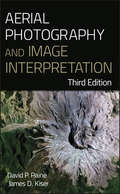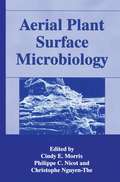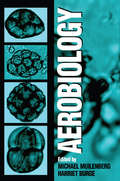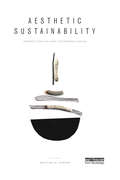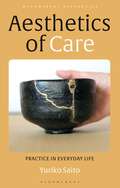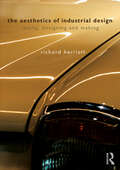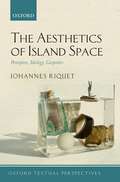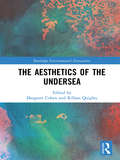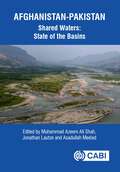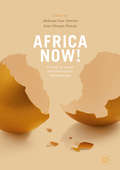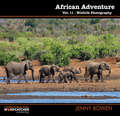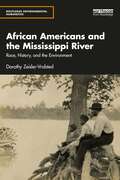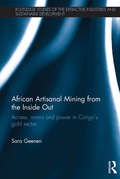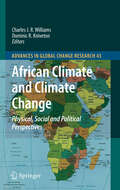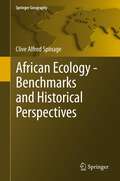- Table View
- List View
Aerial Photography and Image Interpretation
by David P. Paine James D. KiserThe new, completely updated edition of the aerial photography classic Extensively revised to address today's technological advances, Aerial Photography and Image Interpretation, Third Edition offers a thorough survey of the technology, techniques, processes, and methods used to create and interpret aerial photographs. The new edition also covers other forms of remote sensing with topics that include the most current information on orthophotography (including digital), soft copy photogrammetry, digital image capture and interpretation, GPS, GIS, small format aerial photography, statistical analysis and thematic mapping errors, and more. A basic introduction is also given to nonphotographic and space-based imaging platforms and sensors, including Landsat, lidar, thermal, and multispectral. This new Third Edition features: Additional coverage of the specialized camera equipment used in aerial photography A strong focus on aerial photography and image interpretation, allowing for a much more thorough presentation of the techniques, processes, and methods than is possible in the broader remote sensing texts currently available Straightforward, user-friendly writing style Expanded coverage of digital photography Test questions and summaries for quick review at the end of each chapter Written in a straightforward style supplemented with hundreds of photographs and illustrations, Aerial Photography and Image Interpretation, Third Edition is the most in-depth resource for undergraduate students and professionals in such fields as forestry, geography, environmental science, archaeology, resource management, surveying, civil and environmental engineering, natural resources, and agriculture.
Aerial Photography and Image Interpretation
by David P. Paine James D. KiserThe new, completely updated edition of the aerial photography classic Extensively revised to address today's technological advances, Aerial Photography and Image Interpretation, Third Edition offers a thorough survey of the technology, techniques, processes, and methods used to create and interpret aerial photographs. The new edition also covers other forms of remote sensing with topics that include the most current information on orthophotography (including digital), soft copy photogrammetry, digital image capture and interpretation, GPS, GIS, small format aerial photography, statistical analysis and thematic mapping errors, and more. A basic introduction is also given to nonphotographic and space-based imaging platforms and sensors, including Landsat, lidar, thermal, and multispectral. This new Third Edition features: Additional coverage of the specialized camera equipment used in aerial photography A strong focus on aerial photography and image interpretation, allowing for a much more thorough presentation of the techniques, processes, and methods than is possible in the broader remote sensing texts currently available Straightforward, user-friendly writing style Expanded coverage of digital photography Test questions and summaries for quick review at the end of each chapter Written in a straightforward style supplemented with hundreds of photographs and illustrations, Aerial Photography and Image Interpretation, Third Edition is the most in-depth resource for undergraduate students and professionals in such fields as forestry, geography, environmental science, archaeology, resource management, surveying, civil and environmental engineering, natural resources, and agriculture.
Aerial Plant Surface Microbiology
by Cindy E. Morris Philippe C. Nicot Christophe Nguyen-The''Informative, well-constructed, and readable...The contributors are leaders in their fields and what they have to say is worthwhile.'' --- SGM Quarterly, August 1998
Aerobiology
by Michael L. Muilenberg Harriet A. BurgeAerobiology is the study of airborne particles that have an impact on humans and other organisms. Every day, we are exposed to airborne particles, including "natural" particles such as pollen, bacteria, and fungi, and "unnatural" particles, such as asbestos fibers and noxious chemicals. Aerobiology highlights the current interests in this field, primarily the ecology and distribution of airborne particles and their effects on health.
Aerobiology
by Michael L. Muilenberg Harriet A. BurgeAerobiology is the study of airborne particles that have an impact on humans and other organisms. Every day, we are exposed to airborne particles, including "natural" particles such as pollen, bacteria, and fungi, and "unnatural" particles, such as asbestos fibers and noxious chemicals. Aerobiology highlights the current interests in this field, primarily the ecology and distribution of airborne particles and their effects on health.
Aesthetic Sustainability: Product Design and Sustainable Usage (Routledge Studies in Sustainability)
by Kristine H. HarperWhy do we readily dispose of some things, whereas we keep and maintain others for years, despite their obvious wear and tear? Can a greater understanding of aesthetic value lead to a more strategic and sustainable approach to product design? Aesthetic Sustainability: Product Design and Sustainable Usage offers guidelines for ways to reduce, rethink, and reform consumption. Its focus on aesthetics adds a new dimension to the creation, as well as the consumption, of sustainable products. The chapters offer innovative ways of working with expressional durability in the design process. Aesthetic Sustainability: Product Design and Sustainable Usage is related to emotional durability in the sense that the focus is on the psychological and sensuous bond between subject and object. But the subject–object connection is based on more than emotions: aesthetically sustainable objects continuously add nourishment to human life. This book explores the difference between sentimental value and aesthetic value, and it offers suggestions for operational approaches that can be implemented in the design process to increase aesthetic sustainability. This book also offers a thorough presentation of aesthetics, focusing on the correlation between the philosophical approach to the aesthetic experience and the durable design experience. The book is of interest to students and scholars working in the fields of design, arts, the humanities and social sciences; additionally, it will speak to designers and other professionals with an interest in sustainability and aesthetic value.
Aesthetic Sustainability: Product Design and Sustainable Usage (Routledge Studies in Sustainability)
by Kristine H. HarperWhy do we readily dispose of some things, whereas we keep and maintain others for years, despite their obvious wear and tear? Can a greater understanding of aesthetic value lead to a more strategic and sustainable approach to product design? Aesthetic Sustainability: Product Design and Sustainable Usage offers guidelines for ways to reduce, rethink, and reform consumption. Its focus on aesthetics adds a new dimension to the creation, as well as the consumption, of sustainable products. The chapters offer innovative ways of working with expressional durability in the design process. Aesthetic Sustainability: Product Design and Sustainable Usage is related to emotional durability in the sense that the focus is on the psychological and sensuous bond between subject and object. But the subject–object connection is based on more than emotions: aesthetically sustainable objects continuously add nourishment to human life. This book explores the difference between sentimental value and aesthetic value, and it offers suggestions for operational approaches that can be implemented in the design process to increase aesthetic sustainability. This book also offers a thorough presentation of aesthetics, focusing on the correlation between the philosophical approach to the aesthetic experience and the durable design experience. The book is of interest to students and scholars working in the fields of design, arts, the humanities and social sciences; additionally, it will speak to designers and other professionals with an interest in sustainability and aesthetic value.
Aesthetics of Care: Practice in Everyday Life (Bloomsbury Aesthetics)
by Yuriko SaitoBuilding upon her previous work on everyday aesthetics, Yuriko Saito argues in this book that the aesthetic and ethical concerns are intimately connected in our everyday life. Specifically, she shows how aesthetic experience embodies a care relationship with the world and how the ethical relationship with others, whether humans, non-human creatures, environments, or artifacts, is guided by aesthetic sensibility and manifested through aesthetic means. Weaving together insights gained from philosophy, art, design, and medicine, as well as artistic and cultural practices of Japan, she illuminates the aesthetic dimensions of various forms of care in our management of everyday life. Emphasis is placed on the experience of interacting with others including objects, a departure from the prevailing mode of aesthetic inquiry that is oriented toward judgment-making from a spectator's point of view. Saito shows that when everyday activities, ranging from having a conversation and performing a care act to engaging in self-care and mending an object, are ethically grounded and aesthetically informed and guided, our experiences lead to a good life.
Aesthetics of Care: Practice in Everyday Life (Bloomsbury Aesthetics)
by Yuriko SaitoBuilding upon her previous work on everyday aesthetics, Yuriko Saito argues in this book that the aesthetic and ethical concerns are intimately connected in our everyday life. Specifically, she shows how aesthetic experience embodies a care relationship with the world and how the ethical relationship with others, whether humans, non-human creatures, environments, or artifacts, is guided by aesthetic sensibility and manifested through aesthetic means. Weaving together insights gained from philosophy, art, design, and medicine, as well as artistic and cultural practices of Japan, she illuminates the aesthetic dimensions of various forms of care in our management of everyday life. Emphasis is placed on the experience of interacting with others including objects, a departure from the prevailing mode of aesthetic inquiry that is oriented toward judgment-making from a spectator's point of view. Saito shows that when everyday activities, ranging from having a conversation and performing a care act to engaging in self-care and mending an object, are ethically grounded and aesthetically informed and guided, our experiences lead to a good life.
The Aesthetics of Industrial Design: Seeing, Designing and Making
by Richard HerriottThis textbook introduces design students to key principles of three-dimensional form, bridging aesthetics and practical design objectives. It explores how we see and what it is that characterises visually appealing and satisfactory design. Written by an experienced designer, educator and researcher, The Aesthetics of Industrial Design equips students with the knowledge and understanding of how aesthetically superior design is distinct from lesser work. It explains the key principles and concepts they can incorporate into their own designs, encourages readers to investigate and experiment with real design problems and enables them to verbally communicate their design intentions. The book prompts readers to critically reflect on their work and surroundings. Through numerous clear examples and illustrated case studies, which are guided by cognitive science and the application of aesthetic theory, the book brings together the basic aspects of design as form-giving. It explores the balance of function, material and appearance in detail and explains the reasons for common aesthetic faults and how to avoid them. Aimed at undergraduate- and postgraduate-level students within the design fields, this book reveals the secrets to aesthetically successful products that readers can take from education into future practice.
The Aesthetics of Industrial Design: Seeing, Designing and Making
by Richard HerriottThis textbook introduces design students to key principles of three-dimensional form, bridging aesthetics and practical design objectives. It explores how we see and what it is that characterises visually appealing and satisfactory design. Written by an experienced designer, educator and researcher, The Aesthetics of Industrial Design equips students with the knowledge and understanding of how aesthetically superior design is distinct from lesser work. It explains the key principles and concepts they can incorporate into their own designs, encourages readers to investigate and experiment with real design problems and enables them to verbally communicate their design intentions. The book prompts readers to critically reflect on their work and surroundings. Through numerous clear examples and illustrated case studies, which are guided by cognitive science and the application of aesthetic theory, the book brings together the basic aspects of design as form-giving. It explores the balance of function, material and appearance in detail and explains the reasons for common aesthetic faults and how to avoid them. Aimed at undergraduate- and postgraduate-level students within the design fields, this book reveals the secrets to aesthetically successful products that readers can take from education into future practice.
The Aesthetics of Island Space: Perception, Ideology, Geopoetics (Oxford Textual Perspectives)
by Johannes RiquetOxford Textual Perspectives is a series of informative and provocative studies focused upon literary texts (conceived of in the broadest sense of that term) and the technologies, cultures, and communities that produce, inform, and receive them. It provides fresh interpretations of fundamental works and of the vital and challenging issues emerging in English literary studies. By engaging with the materiality of the literary text, its production, and reception history, and frequently testing and exploring the boundaries of the notion of text itself, the volumes in the series question familiar frameworks and provide innovative interpretations of both canonical and less well-known works. The Aesthetics of Island Space discusses islands as central figures in the modern experience of space. It examines the spatial poetics of islands in literary texts, from Shakespeare's The Tempest to Ghosh's The Hungry Tide, in the journals of explorers and scientists such as James Cook and Charles Darwin, and in Hollywood cinema. It traces the ways in which literary and cinematic islands have functioned as malleable spatial figures that offer vivid perceptual experiences as well as a geopoetic oscillation between the material energies of words and images and the energies of the physical world. The chapters focus on America's island gateways (Roanoke and Ellis Island), visions of tropical islands (Tahiti and imagined South Sea islands), the islands of the US-Canadian border region in the Pacific Northwest, and the imaginative appeal of mutable islands. It argues that modern voyages of discovery posed considerable perceptual and cognitive challenges to the experience of space, and that these challenges were negotiated in complex and contradictory ways via poetic engagement with islands. Discussions of island narratives in postcolonial theory have broadened understanding of how islands have been imagined as geometrical abstractions, bounded spaces easily subjected to the colonial gaze. There is, however, a second story of islands in the Western imagination which runs parallel to this colonial story. In this alternative account, the modern experience of islands in the age of discovery went hand in hand with a disintegration of received models of understanding global space. Drawing on and rethinking (post-)phenomenological, geocritical, and geopoetic theories, The Aesthetics of Island Space argues that the modern experience of islands as mobile and shifting territories implied a dispersal, fragmentation, and diversification of spatial experience, and it explores how this disruption is registered and negotiated by both non-fictional and fictional responses.
The Aesthetics of Island Space: Perception, Ideology, Geopoetics (Oxford Textual Perspectives)
by Johannes RiquetOxford Textual Perspectives is a series of informative and provocative studies focused upon literary texts (conceived of in the broadest sense of that term) and the technologies, cultures, and communities that produce, inform, and receive them. It provides fresh interpretations of fundamental works and of the vital and challenging issues emerging in English literary studies. By engaging with the materiality of the literary text, its production, and reception history, and frequently testing and exploring the boundaries of the notion of text itself, the volumes in the series question familiar frameworks and provide innovative interpretations of both canonical and less well-known works. The Aesthetics of Island Space discusses islands as central figures in the modern experience of space. It examines the spatial poetics of islands in literary texts, from Shakespeare's The Tempest to Ghosh's The Hungry Tide, in the journals of explorers and scientists such as James Cook and Charles Darwin, and in Hollywood cinema. It traces the ways in which literary and cinematic islands have functioned as malleable spatial figures that offer vivid perceptual experiences as well as a geopoetic oscillation between the material energies of words and images and the energies of the physical world. The chapters focus on America's island gateways (Roanoke and Ellis Island), visions of tropical islands (Tahiti and imagined South Sea islands), the islands of the US-Canadian border region in the Pacific Northwest, and the imaginative appeal of mutable islands. It argues that modern voyages of discovery posed considerable perceptual and cognitive challenges to the experience of space, and that these challenges were negotiated in complex and contradictory ways via poetic engagement with islands. Discussions of island narratives in postcolonial theory have broadened understanding of how islands have been imagined as geometrical abstractions, bounded spaces easily subjected to the colonial gaze. There is, however, a second story of islands in the Western imagination which runs parallel to this colonial story. In this alternative account, the modern experience of islands in the age of discovery went hand in hand with a disintegration of received models of understanding global space. Drawing on and rethinking (post-)phenomenological, geocritical, and geopoetic theories, The Aesthetics of Island Space argues that the modern experience of islands as mobile and shifting territories implied a dispersal, fragmentation, and diversification of spatial experience, and it explores how this disruption is registered and negotiated by both non-fictional and fictional responses.
The Aesthetics of the Undersea (Routledge Environmental Humanities)
by Margaret Cohen Killian QuigleyAmong global environments, the undersea is unique in the challenges it poses – and the opportunities it affords – for sensation, perception, inquiry, and fantasy. The Aesthetics of the Undersea draws case studies in such potencies from the subaqueous imaginings of Western culture, and from the undersea realities that have inspired them. The chapters explore aesthetic engagements with underwater worlds, and sustain a concern with submarine "sense," in several meanings of that word: when submerged, faculties and fantasies transform, confronting human subjects with their limitations while enlarging the apparent scope of possibility and invention. Terrestrially-established categories and contours shift, metamorphose, or fail altogether to apply. As ocean health acquires an increasing share of the global environmental imaginary, the histories of submarine sense manifest ever-greater importance, and offer resources for documentation as well as creativity. The chapters deal with the sensory, material, and formal provocations of the underwater environment, and consider the consequences of such provocations for aesthetic and epistemological paradigms. Contributors, who hail from the United States, United Kingdom and Australia, include scholars of literature, art, new media, music and history. Cases studies range from baroque and rococo fantasies to the gothic, surrealism, modernism, and contemporary installation art. By juxtaposing early modern and Enlightenment contexts with matters of more recent – and indeed contemporary – importance, The Aesthetics of the Undersea establishes crucial relations among temporally remote entities, which will resonate across the environmental humanities.
The Aesthetics of the Undersea (Routledge Environmental Humanities)
by Margaret Cohen Killian QuigleyAmong global environments, the undersea is unique in the challenges it poses – and the opportunities it affords – for sensation, perception, inquiry, and fantasy. The Aesthetics of the Undersea draws case studies in such potencies from the subaqueous imaginings of Western culture, and from the undersea realities that have inspired them. The chapters explore aesthetic engagements with underwater worlds, and sustain a concern with submarine "sense," in several meanings of that word: when submerged, faculties and fantasies transform, confronting human subjects with their limitations while enlarging the apparent scope of possibility and invention. Terrestrially-established categories and contours shift, metamorphose, or fail altogether to apply. As ocean health acquires an increasing share of the global environmental imaginary, the histories of submarine sense manifest ever-greater importance, and offer resources for documentation as well as creativity. The chapters deal with the sensory, material, and formal provocations of the underwater environment, and consider the consequences of such provocations for aesthetic and epistemological paradigms. Contributors, who hail from the United States, United Kingdom and Australia, include scholars of literature, art, new media, music and history. Cases studies range from baroque and rococo fantasies to the gothic, surrealism, modernism, and contemporary installation art. By juxtaposing early modern and Enlightenment contexts with matters of more recent – and indeed contemporary – importance, The Aesthetics of the Undersea establishes crucial relations among temporally remote entities, which will resonate across the environmental humanities.
Afghanistan-Pakistan Shared Waters: State of the Basins
by Alias Wardak Arif Anwar Fazilda Nabeel Hassaan Furqan Inayatullah Jan Karthikeyan Matheswaran Marie-Charlotte Buisson Muhammad Shahid Iqbal Muhammad Tousif Bhatti Muhammad Zia Hashmi Mujib Ahmad Azizi Paul Pavelic Shakeel Hayat Taimoor AkhtarThere is currently no water cooperation between Afghanistan and Pakistan. Of the nine rivers that flow across the border, none possess a formal agreement or mechanism to manage shared water resources. Further, there is very little information available about the status of environment, hydrology and water resources management for these river basins that could be used as a starting point for dialogues on transboundary water coordination. This State of the Basins book co-develops an overview of the three most important river basins, in collaboration with international experts and water professionals from Afghanistan and Pakistan. It covers water resources, land resources, ecological health, environment, climate change, and the social and economic conditions for sustainable management of these precious resources. It will inform decision making within the two countries, and begin to establish benefits that can accrue from more active collaboration on these shared waters. This book: · Focuses on portions of the Indus shared by Afghanistan and Pakistan. · Features extensive engagement and co-development with Afghan and Pakistani professionals. · Is the first book on the shared waters in the Indus, developed in the context of regional realities associated with post-August 2021 Taliban takeover. The book is aimed at students and researchers in water rights and resources, and government decision makers, private sector investors, donors, intermediary organizations that work directly with farmers, researchers and students. It is a reference book for graduate students and researchers working on these basins, and on transboundary river basin management in Asia and beyond.
Africa Now!: Emerging Issues and Alternative Perspectives
by Adebusuyi Adeniran Lanre IkuteyijoThis book presents relevant and timely endogenous procedures for addressing the challenge of transforming ideas into sustainable opportunities in Africa. It explores how Africa could be understood in the context of emerging global realities, providing alternative frameworks that will not just be participatory in conception and practice, but equally show a contextual workability for the varying aspects of the developmental enterprise in Africa. Despite having alternative and less cumbersome sources of funding, with commendable economic growth indices, and several economies among the fastest growing globally, African countries have been unable to transmute related opportunities into sustainable human development outcomes for majority of its citizenry. Over four rich sections the authors cover subjects ranging from environment and natural resource management, to governance, economy and sustainable development. The book continues with a section on Education and Human Development and a case study in transnationalism. The final section discusses crime, conflict and regional dynamics, including highly disputed topics such as forced migration and sex trade.This indispensable resource will be of great use to students and researches globally in fields such as sociology, anthropology, environmental studies, politics and economics with a focus on contemporary Africa, as well as to policy planners and human rights activists invested in the future development of Africa.
Africa Now!: Emerging Issues and Alternative Perspectives
by Adebusuyi Adeniran Lanre IkuteyijoThis book presents relevant and timely endogenous procedures for addressing the challenge of transforming ideas into sustainable opportunities in Africa. It explores how Africa could be understood in the context of emerging global realities, providing alternative frameworks that will not just be participatory in conception and practice, but equally show a contextual workability for the varying aspects of the developmental enterprise in Africa. Despite having alternative and less cumbersome sources of funding, with commendable economic growth indices, and several economies among the fastest growing globally, African countries have been unable to transmute related opportunities into sustainable human development outcomes for majority of its citizenry. Over four rich sections the authors cover subjects ranging from environment and natural resource management, to governance, economy and sustainable development. The book continues with a section on Education and Human Development and a case study in transnationalism. The final section discusses crime, conflict and regional dynamics, including highly disputed topics such as forced migration and sex trade.This indispensable resource will be of great use to students and researches globally in fields such as sociology, anthropology, environmental studies, politics and economics with a focus on contemporary Africa, as well as to policy planners and human rights activists invested in the future development of Africa.
African Adventure: Wildlife Photography (Creative Portfolio Series #11)
by Jenny BowenAfter graduating as an ecologist from Leeds University I got my first job in Africa, and little did I know the impact this would have on my life. As the permanent ecologist for Raleigh International in Zimbabwe I set up numerous conservation projects, managed hundreds of volunteers, tracked black rhino, and learnt how to survive in the bush. I quickly fell in love with the continent, and over the years Africa has frequently provided restoration for my soul. This was also where I became an avid amateur photographer of all things African. I have spent many happy years working across Africa; as a leader and guide; for a game capture unit in South Africa; and setting up conservation and community projects in Swaziland. I now represent the Kingdom of Swaziland in the UK, as well as giving expert advice to travellers to southern Africa. This experience and passion for Africa – its people, cultures, landscape, and wildlife – led me to create my own business, Sense Africa. I now help people to have their own African Adventure and to sense it for themselves. I hope that you enjoy this snippet of Africa through my camera.
African Americans and the Mississippi River: Race, History, and the Environment (Routledge Environmental Humanities)
by Dorothy Zeisler-VralstedThis book follows the historical trajectory of African Americans and their relationship with the Mississippi River dating back to the 1700s and ending with Hurricane Katrina and the still-contested Delta landscape. Long touted in literary and historical works, the Mississippi River remains an iconic presence in the American landscape. Whether referred to as "Old Man River" or the "Big Muddy," the Mississippi River represents imageries ranging from the pastoral and Acadian to turbulent and unpredictable. However, these imageries—revealed through the cultural production of artists, writers, poets, musicians, and even filmmakers—did not reflect the experiences of everyone living and working along the river. Missing is a broader discourse of the African American community and the Mississippi River. Through the experiences of African Americans with the Mississippi River, which included narratives of labor (free and enslaved), refuge, floods, and migration, a different history of the river and its environs emerges. The book brings multiple perspectives together to explore this rich history of the Mississippi River through the intersection of race and class with the environment. The text will be of great interest to students and researchers in environmental humanities, including environmental justice studies, ethnic studies, and US and African American history.
African Americans and the Mississippi River: Race, History, and the Environment (Routledge Environmental Humanities)
by Dorothy Zeisler-VralstedThis book follows the historical trajectory of African Americans and their relationship with the Mississippi River dating back to the 1700s and ending with Hurricane Katrina and the still-contested Delta landscape. Long touted in literary and historical works, the Mississippi River remains an iconic presence in the American landscape. Whether referred to as "Old Man River" or the "Big Muddy," the Mississippi River represents imageries ranging from the pastoral and Acadian to turbulent and unpredictable. However, these imageries—revealed through the cultural production of artists, writers, poets, musicians, and even filmmakers—did not reflect the experiences of everyone living and working along the river. Missing is a broader discourse of the African American community and the Mississippi River. Through the experiences of African Americans with the Mississippi River, which included narratives of labor (free and enslaved), refuge, floods, and migration, a different history of the river and its environs emerges. The book brings multiple perspectives together to explore this rich history of the Mississippi River through the intersection of race and class with the environment. The text will be of great interest to students and researchers in environmental humanities, including environmental justice studies, ethnic studies, and US and African American history.
African Artisanal Mining from the Inside Out: Access, norms and power in Congo’s gold sector (Routledge Studies of the Extractive Industries and Sustainable Development)
by Sara GeenenArtisanal mining is commonly associated with violent conflict, rampant corruption and desperate poverty. Yet millions of people across Sub Sahara Africa depend on it. Many of them are living in eastern Democratic Republic of Congo (DRC), home to important mineral reserves, but also to a plethora of armed groups and massive human rights violations. African Artisanal Mining from the Inside Out provides a rich and in-depth analysis of the Congolese gold sector. Instead of portraying miners and traders as passive victims of economic forces, regional conflicts or disheartening national policies, it focuses on how they gain access to and benefit from gold. It shows a professional artisanal mining sector governed by a set of specific norms, offering ample opportunities for flexible employment and local livelihood support and being well-connected to the local economy and society. It argues for the viability of artisanal gold mining in the context of weak African states and in the transition towards a post-conflict and more industrialized economy. This book will be of great interest to researchers and postgraduates studying natural resources and development as well as those in development studies, African studies, sociology, political economy, political ecology, legal pluralism, and history.
African Artisanal Mining from the Inside Out: Access, norms and power in Congo’s gold sector (Routledge Studies of the Extractive Industries and Sustainable Development)
by Sara GeenenArtisanal mining is commonly associated with violent conflict, rampant corruption and desperate poverty. Yet millions of people across Sub Sahara Africa depend on it. Many of them are living in eastern Democratic Republic of Congo (DRC), home to important mineral reserves, but also to a plethora of armed groups and massive human rights violations. African Artisanal Mining from the Inside Out provides a rich and in-depth analysis of the Congolese gold sector. Instead of portraying miners and traders as passive victims of economic forces, regional conflicts or disheartening national policies, it focuses on how they gain access to and benefit from gold. It shows a professional artisanal mining sector governed by a set of specific norms, offering ample opportunities for flexible employment and local livelihood support and being well-connected to the local economy and society. It argues for the viability of artisanal gold mining in the context of weak African states and in the transition towards a post-conflict and more industrialized economy. This book will be of great interest to researchers and postgraduates studying natural resources and development as well as those in development studies, African studies, sociology, political economy, political ecology, legal pluralism, and history.
African Climate and Climate Change: Physical, Social and Political Perspectives (Advances in Global Change Research #43)
by Charles J. R. J.R. Williams and Dominic R. R. KnivetonCompared to many other regions of the world, Africa is particularly vulnerable to the effects of climate change and variability. Widespread poverty, an extensive disease burden and pockets of political instability across the continent has resulted in a low resilience and limited adaptative capacity of African society to climate related shocks and stresses. To compound this vulnerability, there remains large knowledge gaps on African climate, manifestations of future climate change and variability for the region and the associated problems of climate change impacts. Research on the subject of African climate change requires an interdisciplinary approach linking studies of environmental, political and socio-economic spheres. In this book we use different case studies on climate change and variability in Africa to illustrate different approaches to the study of climate change in Africa from across the spectrum of physical, social and political sciences. In doing so we attempt to highlight a toolbox of methodologies (along with their limitations and advantages) that may be used to further the understanding of the impacts of climate change in Africa and thus help form the basis for strategies to negate the negative implications of climate change on society.
African Ecology: Benchmarks and Historical Perspectives (Springer Geography)
by Clive Alfred SpinageIn view of the rapidly changing ecology of Africa ,this work provides benchmarks for some of the major, and more neglected, aspects, with an accent on historical data to enable habitats to be seen in relation to their previous state, forming a background reference work to understanding how the ecology of Africa has been shaped by its past. Reviewing historical data wherever possible it adopts an holistic view treating man as well as animals, with accent on diseases both human and animal which have been a potent force in shaping Africa’s ecology, a role neglected in ecological studies.
